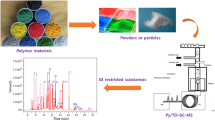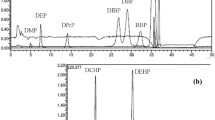Abstract
A polystyrene (PS) certified reference material (CRM) for the analysis of decabromodiphenyl ether (BDE 209) was issued. PS disk was prepared by injection molding of the mixture of versine PS and BDE 209. The certification of the PS CRM was conducted by two analytical methods with different sample preparation methods using isotope dilution mass spectrometry (IDMS). The certified value, wCRM, was 978 mg/kg, and this value coincided with the regulation value of BDE 209 in the Restriction of Hazardous Substances directive (1000 mg/kg). The uncertainties related to certification, uwmean, inhomogeneity, uhom, and long- and short-term instability, usts and ults, respectively, were evaluated based on the mass fraction of BDE 209. The uwmean, uhom, usts, and ults were 0.0265, 0.0046, 0.0061, and 0.0099 (relative), respectively, and the expanded uncertainty for this CRM was determined as 57 mg/kg (coverage factor is 2). Additionally, the quantitative capability of the thermal desorption-gas chromatography/mass spectrometry (TD-GC/MS) method was evaluated. In TD-GC/MS, the analytical values of the developed CRM obtained by the external and internal standard methods with matrix-free calibrants were out of the range of the wCRM (almost 10% larger or smaller), whereas those with matrix-matched calibrants agreed with the wCRM. In contrast to these results, the analytical values obtained by TD-GC/MS using IDMS were consistent with the wCRM no matter if matrix-free or matrix-matched calibrants were used. These results indicated that, for quantification of BDE 209 in PS, the trueness and precision of TD-GC/MS can be enhanced by applying IDMS without matrix-matched calibrants.







Similar content being viewed by others
References
Darnerud PO. Toxic effects of brominated flame retardants in man and in wildlife. Environ. Int. 2003;29:841–53. https://doi.org/10.1016/S0160-4120(03)00107-7.
Erickson PR, Grandbois M, Arnold WA, McNeill K. Photochemical formation of brominated dioxins and other products of concern from hydroxylated polybrominated diphenyl ethers (OH-PBDEs). Environ. Sci. Technol. 2012;46:8174–80. https://doi.org/10.1021/es3016183.
Donohue JM, Galal-Gorchev H, Zhao Q, Gadagbui B, Maier A. Toxicological review of decabromodiphenyl ether (BDE-209) (CAS No. 1163-19-5). U.S. Environmental Protection Agency. 2008. https://iris.epa.gov/static/pdfs/0035tr.pdf. Accessed 20 July 2023.
Darnerud PD, Eriksen GS, Jóhannesson T, Larsen PB, Viluksela M. Polybrominated diphenyl ethers: occurrence, dietary exposure, and toxicology. Environ. Health Perspect. 2001;109:49–68. https://doi.org/10.1289/ehp.01109s149.
**e Z, Zhang P, Wu Z, Zhang S, Wei L, Mi L, Kuester A, Gandrass J, Ebinghaus R, Yang R, Wang Z, Mi W. Legacy and emerging organic contaminants in the polar regions. Sci. Total Environ. 2022:155376. https://doi.org/10.1016/j.scitotenv.2022.155376.
Directive 2011/65/EU of the European Parliament and of the Council of 8 June 2011 on the restriction of the use of certain hazardous substances in electrical and electronic equipment. European Union. https://eur-lex.europa.eu/legal-content/EN/TXT/?uri=CELEX:32011L0065. Accessed 20 July 2023.
IEC 62321-6, Determination of certain substances in electrotechnical products - Part 6: Polybrominated biphenyls and polybrominated diphenyl ethers in polymers by gas chromatography -mass spectrometry (GC-MS). International Electrotechnical Commission; 2015.
IEC 62321-3-3, Determination of certain substances in electrotechnical products - Part 3-3: Screening - Polybrominated biphenyls, polybrominated diphenyl ethers and phthalates in polymers by gas chromatography-mass spectrometry using a pyrolyser/thermal desorption accessory (Py/TD-GC-MS). International Electrotechnical Commission; 2021.
ERM-EC590 POLYETHYLENE (Br, BDE and BB in LDPE). European Commission. https://crm.jrc.ec.europa.eu/p/40455/40468/By-material-matrix/Other-manufactured-materials/ERM-EC590-POLYETHYLENE-Br-BDE-and-BB-in-LDPE/ERM-EC590. Accessed 6 October 2023.
ERM-EC591 POLYPROPYLENE (Br, BDE and BB in PP). European Commission. https://crm.jrc.ec.europa.eu/p/40455/40468/By-material-matrix/Other-manufactured-materials/ERM-EC591-POLYPROPYLENE-Br-BDE-and-BB-in-PP/ERM-EC591. Accessed 6 October 2023.
ABS certified reference material for analysis of brominated flame retardants. Korea Testing Laboratory. https://www.comar.bam.de/showCertificate/469900. Accessed 6 October 2023.
Matsuyama S, Kinugasa S, Ohtani H. Development of certified reference materials of plastics containing decabrominated diphenyl ether. Bunseki Kagaku. 2011;60:301–5. https://doi.org/10.2116/bunsekikagaku.60.301.
ISO Guide 35:2006, “Reference materials – general and statistical principles for certification”.
Richter W. Primary methods of measurement in chemical analysis. Accred. Qual. Assur. 1997;2:354–9. https://doi.org/10.1007/s007690050165.
Yuzawa T, Hosaka A, Watanabe C, Tsuge S. Evaluation of the thermal desorption–GC/MS method for the determination of decabromodiphenyl ether (DeBDE) in order of a few hundred ppm contained in a certified standard polystyrene sample. Anal. Sci. 2008;24:953–5. https://doi.org/10.2116/analsci.24.953.
Hosaka A, Watanage C, Tsuge S. Rapid determination of decabromodiphenyl ether in polystyrene by thermal desorption-GC/MS. Anal. Sci. 2005;21:1145–7. https://doi.org/10.2116/analsci.21.1145.
Akoueson F, Chbib C, Monchy S, Paul-Pont I, Doyen P, Dehaut A, Duflos G. Identification and quantification of plastic additives using pyrolysis-GC/MS: a review. Sci. Total Environ. 2021;773:145073. https://doi.org/10.1016/j.scitotenv.2021.145073.
Seeley ME, Lynch JM. Previous successes and untapped potential of pyrolysis–GC/MS for the analysis of plastic pollution. Anal. Bio. Chem. 2023;415:2873–90. https://doi.org/10.1007/s00216-023-04671-1.
Zhang T, Ye X, Luo X, Niu Z, Wang H, Ma Q. Simultaneous screening of 33 restricted substances in polymer materials using pyrolysis/thermal desorption gas chromatography–mass spectrometry. Anal. Bioanal. Chem. 2023;415:2873–90. https://doi.org/10.1007/s00216-023-04819-z.
ISO Guide 35:2017, “Reference materials - guidance for characterization and assessment of homogeneity and stability”.
Yu S, Xu X. Study of matrix-induced effects in multi-residue determination of pesticides by online gel permeation chromatography-gas chromatography/mass spectrometry. Rapid Commun. Mass Spectrom. 2012;26:963–77. https://doi.org/10.1002/rcm.6193.
Poole CF. Matrix-induced response enhancement in pesticide residue analysis by gas chromatography. J. Chromatgr. A. 2007;1158:241–50. https://doi.org/10.1016/j.chroma.2007.01.018.
Yarita T, Aoyagi Y, Otake T. Evaluation of the impact of matrix effect on quantification of pesticides in foods by gas chromatography–mass spectrometry using isotope-labeled internal standards. J. Chromatgr. A. 2015;1396:109–16. https://doi.org/10.1016/j.chroma.2015.03.075.
Author information
Authors and Affiliations
Corresponding author
Ethics declarations
Conflict of interest
The authors declare no competing interests.
Additional information
Publisher’s note
Springer Nature remains neutral with regard to jurisdictional claims in published maps and institutional affiliations.
Supplementary information
ESM 1
(DOCX 102 kb)
Rights and permissions
Springer Nature or its licensor (e.g. a society or other partner) holds exclusive rights to this article under a publishing agreement with the author(s) or other rightsholder(s); author self-archiving of the accepted manuscript version of this article is solely governed by the terms of such publishing agreement and applicable law.
About this article
Cite this article
Nakamura, K., Matsuyama, S., Orihara, Y. et al. Improvement of the quantitativeness of the thermal desorption-GC/MS method and development of polystyrene certified reference material for the quantification of decabromodiphenyl ether (BDE 209) by using isotope dilution mass spectrometry. Anal Bioanal Chem 416, 407–417 (2024). https://doi.org/10.1007/s00216-023-05032-8
Received:
Revised:
Accepted:
Published:
Issue Date:
DOI: https://doi.org/10.1007/s00216-023-05032-8




